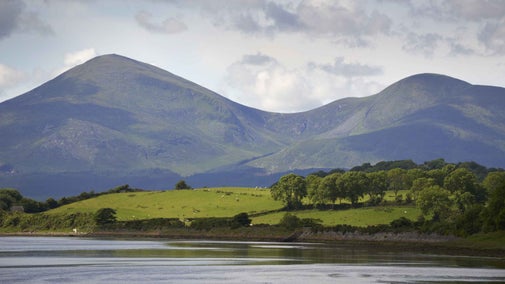
Discover more at Crom
Find out when Crom is open, how to get here, the things to see and do and more.

The 2,000 acres of parkland at Crom lie beside the shores of Upper Lough Erne, an ancient landscape which includes the ruins of the old castle. Home to a variety of plants and animals, the diversity of habitats makes Crom an important conservation site.
The main entrance to Crom is surrounded by parkland. Sheep and cattle keep the grass short during the growing season and large trees providing shelter in the rain.
The habitat supports a diversity of bird species which love searching for worms in the short turf and exposed soil torn up by the livestock. You’ll often see pied wagtails and starlings as well as fieldfares and redwings during the winter, taking advantage of the buffet that’s on offer.

The old castle at Crom was built in the early 17th century by a Scottish planter, Michael Balfour. The castle survived two sieges by the Jacobites in 1689, but accidentally burnt down in 1764.
According to tradition, the fire took place when the owner Abraham Crichton was returning in his boat from a housewarming party at Florence Court. Crichton saw a glow in the sky, and returned home to find his castle gutted.
In the 19th century additional walls and towers were added to the ruins of the old castle for romantic effect. Today, the ruins are a secluded monument.
Close to the castle ruins are Crom’s famous Yew Trees. They are a conjoined pair of a male and female yew, with a combined circumference of 377 feet (115m) and a diameter of 115 feet (35m). The larger, older female yew is of a considerable age, although how old exactly has been the subject of debate for many years. They have been named among Britain's 50 greatest trees.
The earliest known reference to the tree is from 1739, when it was described as an already venerable tree. The male tree is much younger, and was most likely planted in the 19th century.
Ireland has very little native broadleaved woodland remaining but Crom is home to a large portion of it. The woodland is dominated by oak trees, which are known to support the greatest diversity of life in terms of lichens, mosses, invertebrates and even birds and mammals.
Crom is also home to large areas of species-rich grassland teeming with life, from wildflowers to a whole host of invertebrates. Flowers like ragged robin, meadowsweet and purple loosestrife love the soggy ground and support a variety of bee, butterfly and moth species who in turn support the dragonfly and damselfly species who prey on them.
The grassland takes careful management as without grazing or regular cutting the grasslands would swallow up the diverse flora, decimating the array of invertebrates that depend on them.
Another important habitat at Crom is Lough Erne itself, celebrated for its peace, tranquillity, beauty and above all its wildlife. The area is well known for its lichens and fungi, while rare and endangered plants can be found here, including blue-eyed grass, which is unique to Fermanagh.
In bird hide has been erected on the shores of Derrymacrow Lough. This provides visitors with the opportunity to enjoy some of the rich and varied wildlife in a corner of Crom which is not usually visited.
The hide is on a raised platform, giving good views over the loughside vegetation and is accessible to all, with an access ramp and viewing slot for wheelchair users. Binoculars are available, providing close-up views of the various species on the lough, while the hide is also equipped with identification guides and notebooks for visitors to record what they see during their visits.

Find out when Crom is open, how to get here, the things to see and do and more.

Enjoy a boat trip on Lough Erne, or experience the best coarse fishing in Northern Ireland. Stop off at an island or two, and see the estate from the vantage point of the water.

Take a look at the volunteer opportunities available at Crom and see whether volunteering here could be for you.

Crom was requisitioned by the War Office from November 1940 and become a base for hundreds of US troops. Discover more about the legacy of WW2 at Crom.

Plan a visit to one of the special countryside places in our care and discover the benefits of being in the great outdoors. Pack your walking boots and get ready to explore woodlands, valleys and rivers.

Explore some of the finest landscapes in our care on coastal paths, accessible trails, woodland walks and everything in between. Find the best places to walk near you.

Whether you're looking for a heart-raising hike up Northern Ireland's highest mountain or a ramble by the river at The Argory, there are many countryside and woodland places to experience in Northern Ireland. Enjoy woodland respite at Minnowburn with the forest bathing beds or escape to the wild landscape of County Fermanagh with the countryside adventures at Florence Court, Castle Coole and Crom.